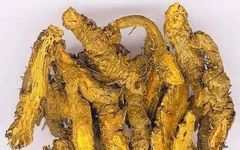Note: Some text and image resources in this article are sourced from the internet. The purpose of reposting this article is to convey more information. If there are any errors in source attribution or infringement of your legal rights, please notify us immediately, and we will delete it promptly and apologize.
Huang Lian (Coptis chinensis), also known as Chuan Lian, Ya Lian, and Yun Lian, is the dried rhizome of the plant from the family Ranunculaceae. According to the Shen Nong Ben Cao Jing, it is bitter and cold in nature. It is indicated for heat, eye pain, injury to the eyes, excessive tearing, vision improvement, intestinal pain, abdominal pain with diarrhea, and swelling and pain in women’s genitalia. Long-term use can enhance memory. Huang Lian has the effect of clearing heat and drying dampness, and can be used for damp-heat accumulation, vomiting, and diarrhea caused by gastrointestinal damp-heat. It also has detoxifying, fire-clearing, and anti-parasitic effects, useful for febrile diseases with high fever, thirst, irritability, blood heat, and heat toxin sores, as well as ascariasis. Huang Lian has effects such as clearing fire, detoxifying, clearing heat, drying dampness, anti-inflammatory, anti-ulcer, antioxidant, protecting gastric mucosa, increasing coronary blood flow, and lowering blood pressure. Huang Lian is grayish-yellow on the surface, with irregular nodular protrusions, and bright yellow on the cut surface. Let’s explore the efficacy and usage of Huang Lian!
01
The Efficacy of Huang Lian
1. Clearing Heat and Reducing Fire
In Traditional Chinese Medicine (TCM), Huang Lian is used with other auxiliary herbs for both damp-heat and fire-heat syndromes. Huang Lian is bitter and cold, with strong fire-clearing and detoxifying effects. It can be used for damp-heat obstruction, febrile diseases with high fever, and irritability. For damp-heat, it is often combined with Ban Xia (Pinellia ternata) and Gua Lou (Trichosanthes fruit), while for fire-heat, it is often combined with Zhu Sha (Cinnabar) and Di Huang (Rehmannia glutinosa).
2. Assisting in Malaria
In TCM, Huang Lian has been used to assist in treating malaria and severe diarrhea. Huang Lian contains berberine, which is also recognized in modern medicine as an over-the-counter diarrhea medication. Berberine has antibacterial properties, inhibiting pathogens such as Shigella, Mycobacterium tuberculosis, Streptococcus pneumoniae, Salmonella, and Corynebacterium diphtheriae, with the strongest effect against Shigella, making it an effective remedy for bacterial gastroenteritis and dysentery.
3. Assisting in Gastrointestinal Inflammation
Gastritis, gastric ulcers, gastroenteritis, and enteritis are often difficult to treat. Many medications can irritate the gastrointestinal tract, providing some relief but also causing stimulation. Controlling the dosage accurately can be challenging. Huang Lian, however, is different; its main component, berberine, does not enter the bloodstream through the gastrointestinal mucosa but remains in the gastrointestinal tract. Its bitter nature prolongs the retention time of berberine in the gastrointestinal tract, significantly aiding in gastrointestinal inflammation.
4. Antibacterial Effects
Huang Lian exhibits antibacterial activity against Staphylococcus aureus, Streptococcus pyogenes, Streptococcus pneumoniae, Neisseria meningitidis, Shigella, Bacillus anthracis, and others.

02
Usage and Dosage of Huang Lian
Tea Preparation
3 grams of Huang Lian, 5 grams of green tea, and 15 grams of sugar. Brew with 200 ml of boiling water for 5-10 minutes, and drink until the flavor is mild. This drink has the effects of clearing fire, detoxifying, quenching thirst, and clearing stomach heat.
Porridge Preparation
10 grams each of Huang Lian and Bai Tou Weng (Pulsatilla), and 30 grams of japonica rice. Place Huang Lian and Bai Tou Weng in a clay pot, add water, and simmer for a while to extract the juice. In another pot, add 400 ml of water and the rice, cooking until the rice is done, then add the medicinal juice and cook until it becomes porridge. This porridge can clear heat and detoxify.
Decoction
For insomnia (Yin deficiency with excessive fire): 1 gram of Huang Lian, 5 grams of He Huan Hua (Mimosa flower), 3 grams of Yu Jin (Curcuma), and 5 grams of Ye Jiao Teng (Polygoni multiflori vine), all cut into small pieces. Decoction and take before bed daily.
For gastritis (Spleen deficiency with damp obstruction): 10 grams each of Huang Lian and Hou Po (Magnolia bark), and 5 grams each of Ban Xia and Gan Cao (Licorice). Decoction and take once daily.
Usage Precautions
Suitable for those with damp-heat constitution. Not suitable for those with spleen and stomach deficiency-cold or Yin deficiency with fluid damage.
Properties and Channels
Cold in nature, bitter in taste, entering the Heart, Spleen, Stomach, Liver, Gallbladder, and Large Intestine channels.
How to Select
Choose those that are dry, thin, with many joints, few root hairs, and yellow in color as the best quality.
More exciting recommendations:
About 60,000 “college students” with AIDS, with 4 abnormalities in the body, most have entered the “window period.”
The efficacy and effects of Huang Qi (Astragalus), its side effects and contraindications.
About 60,000 “college students” with AIDS, with 4 abnormalities in the body, most have entered the “window period.”

